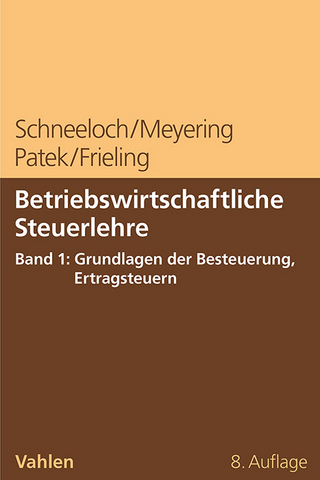
Business Valuation and Federal Taxes
John Wiley & Sons Inc (Verlag)
978-0-470-60162-4 (ISBN)
Business Valuation and Federal Taxes Procedure, Law, and Perspective
SECOND EDITION
Combining the expert knowledge of Senior Judge David Laro and Shannon Pratt, Business Valuation and Federal Taxes, Second Edition presents the authors' decades of experience, with advice on everything practitioners need to know about the relationship between federal taxes and valuation, and specifically valuations relating to business interests. This reference features indepth examinations of numerous topics that are particularly important to practitioners and explores a broad understanding of the basic knowledge needed to appreciate business valuation.
Valuators, CPAs consulting on valuations, attorneys, corporate development officers, and intermediaries on business valuation will benefit from insightful discussions on topics ranging from general definitions to valuing complex business interests, as well as new discussions of:
Personal versus enterprise goodwill
New materials on transfer pricing and customs valuations and how recent markets have affected both the income and market approaches
Coverage of FAS 157 and the many changes to penalties and sanctions affecting both taxpayers and appraisers
Several important new court cases
Coverage is also included on standards of business valuation, IRS positions, burden of proof in valuation controversies, questions to ask business valuation experts, economic and industry analysis, and tax-affecting passthrough entities.
Complete with a full overview of the laws, procedures, and approaches related to business valuation, this invaluable reference is a wellspring of vital information on valuation approaches, techniques, finance-related issues, burden of proof, standards, choice of entity, and much more.
SENIOR JUDGE DAVID LARO was appointed to the United States Tax Court, confirmed by the Senate, and invested as a federal judge in November 1992. He formerly practiced law in Flint and Ann Arbor, Michigan, for twenty-four years, specializing in tax law. Senior Judge Laro was chairman and CEO of a publicly traded international company, and he cofounded Republic Bancorp, a Michigan bank holding company. He is an adjunct professor of law at Georgetown University Law School and a visiting professor at the University of San Diego Law School. SHANNON P. PRATT is one of the most successful and respected authors in the field of business valuations. He has authored many industry standard books, including Cost of Capital, Fourth Edition; Business Valuation Discounts and Premiums, Second Edition; and The Market Approach to Valuing Businesses, Second Edition, all published by Wiley. Over a distinguished career of more than four decades, he has performed valuation engagements for M&A, ESOPs, and numerous other purposes. He is also Editor Emeritus of Shannon Pratt's Business Valuation Update, the premier monthly newsletter in the field of business valuation. Dr. Pratt is CEO of Shannon Pratt Valuations, a business valuation firm located in Portland, Oregon.
Foreword to Second Edition xv
Foreword: Legal Practitioner’s Perspective xvii
Foreword: Law Professor’s Perspective xix
Foreword: Business Appraiser’s Perspective xxi
Preface to the New Edition xxiii
Origin of the Book xxiii
Authors Provide Own Perspectives xxiv
Topics Covered xxiv
Acknowledgments xxvii
About the Authors xxix
Chapter 1 Standards of Business Valuation 1
Summary 1
Introduction 2
Sources for Defining Value 3
Definitions of Value 7
Premise of Value 17
Conclusion 18
Chapter 2 Subsequent Events 19
Summary 19
Key Question 19
Valuation Date 20
Subsequent Events—Exceptions 21
Conclusion 27
Chapter 3 Business Valuation Experts 28
Summary 28
Introduction 29
Proving Business Value 29
The Expert Appraiser 30
Types of Experts 31
Various Roles of Experts 32
Business Valuation Litigation Witnesses 32
Admissibility of Evidence Underlying Expert Opinions 33
Limitations to Admissibility 35
Reliability of the Expert 36
Minimum Thresholds for the Business Valuation Expert 38
Sarbanes-Oxley Act of 2002 40
Attorney Assistance to the Expert 40
Qualified Appraiser 43
Concerns about Expert Testimony 44
Court-Appointed Expert 46
Conclusion 48
Appendix: Expert Credentials and Qualifications 49
Chapter 4 Sources of Law and Choice of Courts 58
Summary 58
Structure of the American Legal System 59
Tax Law 60
Tax Litigation 62
Conclusion 66
Chapter 5 Burden of Proof in Valuation Controversies 67
Summary 67
Burden of Proof 69
Who Bears the Burden of Proof? 71
Burden of Proof: Exceptions to the General Rule 71
Chapter 6 Penalties and Sanctions 76
Summary 76
Introduction 77
Valuation Penalties 78
Preparer and Appraiser Penalties 81
General Penalties 82
Discretionary Sanctions 84
Chapter 7 How the Form of Entity Affects Valuation 86
Summary 86
Introduction 87
Corporations 88
General Partnerships 89
Limited Partnerships 89
Limited Liability Companies 91
Sole Proprietorships 91
Tax Classifications 91
Valuation Considerations 92
Entity-Level Discounts 94
Choice of Jurisdiction 95
Conclusion 97
Chapter 8 Valuation of S Corporations and Other Pass-Through Tax Entities: Minority and Controlling Interests 98
Introduction 98
Case Law Background 100
S Corporation Minority Interest Appraisals 104
Comparison of Minority Interest Theories—A Summary of the Issues 106
S Corporation Controlling Interest Appraisals 108
General S Corporation Appraisal Considerations 110
Conclusion 110
Chapter 9 Transfer Pricing 112
Summary 112
Introduction 113
Conclusion 123
Chapter 10 Customs Valuation 124
Summary 124
Introduction 125
Customs Valuation Methods and Concepts 125
Related-Party Transactions 130
Conclusion 132
Chapter 11 Adjustments to Financial Statements 133
Summary 133
Separating Nonoperating Items from Operating Items 134
Addressing Excess Assets and Asset Deficiencies 135
Handling Contingent Assets and Liabilities 135
Adjusting Cash-Basis Statements to Accrual-Basis Statements 136
Normalizing Adjustments 136
Controlling Adjustments 137
Conclusion 139
Chapter 12 Comparative Financial Statement Analysis 140
Summary 140
Comparable Ratio Analysis 142
Common Size Statements 147
Tying the Financial Statement Analysis to the Value Conclusion 147
Conclusion 148
Chapter 13 Economic and Industry Analysis 149
Summary 149
Objective of Economic and Industry Analysis 150
International Economic Analysis 150
National Economic Analysis 150
Regional and Local Economic Analysis 151
Industry Analysis 151
Conclusion 153
Partial Bibliography of Sources for Economic and Industry Analysis 153
Chapter 14 Site Visits and Interviews 159
Summary 159
Site Visits 159
Management Interviews 160
Interviews with Persons Outside the Company 160
Conclusion 161
Chapter 15 The Income Approach 162
Summary of Approaches, Methods, and Procedures 162
Introduction to the Income Approach 163
Net Cash Flow: The Preferred Measure of Economic Benefit in the Income Approach 164
Discounting versus Capitalizing 166
Relationship between Discount Rate and Capitalization Rate 166
Projected Amounts of Expected Returns 172
Developing Discount and Capitalization Rates for Equity Returns 172
Weighted Average Cost of Capital (WACC) 176
The Midyear Convention 177
The Income Approach in the Courts 179
Conclusion 185
Appendix: An Illustration of the Income Approach to Valuation 186
Chapter 16 The Market Approach 195
Summary 196
The Market Approach 196
Revenue Ruling 59-60 Emphasizes Market Approach 196
The Guideline Public Company and the Guideline Transaction (Merger and Acquisition) Method 197
How Many Guideline Companies? 202
Selection of Guideline Companies 204
Documenting the Search for Guideline Companies 206
Choosing Multiples Based on Objective Empirical Evidence 206
What Prices to Use in the Numerators of the Market Valuation Multiples 206
Choosing the Level of the Valuation Multiple 207
Selecting Which Valuation Multiples to Use 209
Assigning Weights to Various Market Multiples 211
Sample Market Valuation Approach Tables 211
Other Methods Classified Under the Market Approach 211
Conclusion 216
Appendix: An Illustration of the Market Approach to Valuation 217
Chapter 17 The Asset-Based Approach 243
Summary 243
Adjusted Net Asset Value Method 243
Excess Earnings Method (The Formula Approach) 244
Conclusion 248
Chapter 18 Entity-Level Discounts 249
Summary 249
Trapped-In Capital Gains Discount 250
Key Person Discount 256
Portfolio (Nonhomogeneous Assets) Discount 263
Discount for Contingent Liabilities 267
Conclusion 269
Chapter 19 Minority Discounts/Control Premiums 271
Summary 271
Minority Discounts/Control Premiums 271
Conclusion 278
Chapter 20 Discounts for Lack of Marketability 279
Summary: General Introduction to Shareholder-Level Discounts and Premiums 280
Definition of Marketability 281
Benchmark for Marketability Is Cash in Three Days 281
Investors Cherish Liquidity, Abhor Illiquidity 282
Degrees of Marketability or Lack Thereof 283
Empirical Evidence to Quantify Discounts for Lack of Marketability: Restricted Stock Studies 283
Empirical Evidence to Quantify Discounts for Lack of Marketability: Pre-IPO Studies 290
Criticisms of the Pre-IPO Studies 292
Factors Affecting the Magnitude of Discounts for Lack of Marketability 294
Use of the Databases for Quantifying Discounts for Lack of Marketability 297
Discounts for Lack of Marketability for Controlling Interests 300
Option Pricing as Indicator of DLOM 305
Discounts for Lack of Marketability in the Courts 309
Conclusion 319
Partial Bibliography of Sources for Discounts for Lack of Marketability 320
Chapter 21 Other Shareholder-Level Discounts 321
Summary 321
Voting versus Nonvoting Shares 321
Blockage 324
Discounts for Undivided Fractional Interests in Property 330
Conclusion 332
Chapter 22 Personal versus Enterprise Goodwill 333
Summary 333
Definitions of Goodwill 334
Tax Implications 334
Indications of Personal versus Enterprise Goodwill 334
Landmark Cases 335
Excerpt from Personal Goodwill Appraisal Report 339
Conclusion 342
Chapter 23 Weighting of Approaches 343
Summary 343
Theory and Practice 343
Mathematical versus Subjective Weighting 344
Examples of Weighting of Approaches 345
Conclusion 347
Chapter 24 IRS Positions 348
Summary 348
Introduction 349
Rev. Rul. 59-60 350
Rev. Rul. 65-192 358
Rev. Rul. 65-193 362
Rev. Proc. 66-49 363
Rev. Rul. 68-609 366
Rev. Proc. 77-12 368
Rev. Rul. 77-287 370
Rev. Rul. 83-120 376
Rev. Rul. 85-75 379
Rev. Rul. 93-12 381
Tax Advice Memorandum 9436005 383
Rev. Proc. 2003-51 386
Rev. Proc. 2007-41 390
Rev. Rul. 2008-35 393
Chapter 25 Business Appraisal Reports 399
Summary 400
Business Valuation Report-Writing Standards 400
Elements of the Business Valuation Report 412
Organization of the Report 418
Qualities of a Good Appraisal Report 418
Conclusion 419
Chapter 26 Valuation of Options 420
Summary 420
Introduction and Background 421
General Principles of Option Valuation 422
Specific Rules for Valuing Options 427
Conclusion 433
Chapter 27 Questions to Ask Business Valuation Experts 434
Summary 434
Qualifications 434
Financial Statement Adjustments and Analysis 435
Economic and Industry Data 436
Site Visits and Interviews 436
General Questions about Methodology 436
Discount and Capitalization Rates in the Income Approach 436
Projections Used in the Income Approach 438
The Market Approach 438
Asset-Based Approach 438
Entity-Level Discounts 438
Minority Interest Discounts/Control Premiums 439
Discounts for Lack of Marketability 439
Voting/Nonvoting Stock 439
Questions about Contradictory Prior Testimony 439
Appendix A International Glossary of Business Valuation Terms 441
Appendix B Bibliography 447
Books 447
Articles and Papers 448
Periodicals 450
Mergers and Acquisitions Databases 451
Discount for Lack of Marketability Databases 452
Table of Cases 453
Index 461
| Verlagsort | New York |
|---|---|
| Sprache | englisch |
| Maße | 185 x 262 mm |
| Gewicht | 1080 g |
| Themenwelt | Recht / Steuern ► Steuern / Steuerrecht |
| Wirtschaft ► Betriebswirtschaft / Management ► Finanzierung | |
| Wirtschaft ► Volkswirtschaftslehre ► Wirtschaftspolitik | |
| ISBN-10 | 0-470-60162-0 / 0470601620 |
| ISBN-13 | 978-0-470-60162-4 / 9780470601624 |
| Zustand | Neuware |
| Informationen gemäß Produktsicherheitsverordnung (GPSR) | |
| Haben Sie eine Frage zum Produkt? |
aus dem Bereich


